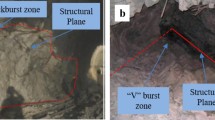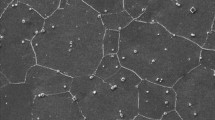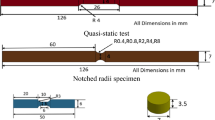Abstract
A 3D finite element model of the explosive welding process of three-layer plates with materials of steel-copper-copper is established. Based on the presented model, the bonding mechanism is simulated and analyzed, different detonation modes are also comparatively studied to indicate the driving force spread in few microseconds. The results show that the three layer plates bond together after many times of impact between the flyers and the base driven by detonation wave, which is damping rapidly at each impact with wavelength decreasing. The pressure at the detonation point is minimal, which induces non-bonding of the plates here. Detonation wave propagates in concentric circle both under side-midpoint detonation mode and under center-point detonation mode, but the movement of the flyer is different, which makes non-bonding easily occur at the end of detonation under side-midpoint detonation and at the center of the plate under center-point detonation.
Similar content being viewed by others
References
Blazinski T Z. Explosive Welding, Forming and Compaction. New York: Elsevier Science, 1983. 159–187
Crossland B. Explosive Welding of Metals and Its Application. New York: Oxford University Press, 1882. 233–240
Zhang Y, Babu S S, Prothe C, et al. Application of high velocity impact welding at varied different length scales. J Mater Process Technol, 2011, 211: 944–952
Hokamoto K, Chiba A, Fujita M. Single-shot explosive welding technique for the fabrication of multilayered metal base composites: effect of welding parameters leading to optimum bonding condition. Compos Eng, 1995, 5: 1069–1079
Han J H, Ahn J P, Shin M C. Effect of interlayer thickness on shear deformation behavior of AA5083 aluminum alloy/SS41 steel plates manufactured by explosive welding. J Mater Sci, 2003, 38: 13–18
Manikandan P, Hokamoto K, Fujita M, et al. Control of energetic conditions by employing interlayer of different thickness for explosive welding of titanium/304 stainless steel. J Mater Process Technol, 2008, 195: 232–240
Hokamoto K, Izuma T, Fujita M. New explosive welding technique to weld aluminum alloy and stainless steel plates using a stainless steel intermediate plate. Metall Trans A, 1993, 24A: 2289–2297
Mousavi S A A A, Sartangi P F. Experimental investigation of explosive welding of cp-titanium/AISI 304 stainless steel. Mater Des, 2009, 30: 459–468
Grignon F, Benson D, Vecchio K S, et al. Explosive welding of aluminum to aluminum: Analysis, computations and experiments. Int J Impact Eng, 2004, 30: 1333–1351
Durgutlu A, Gulenc B, Findik F. Examination of copper/stainless steel joints formed by explosive welding. Mater Des, 2005, 26: 497–507
Kahraman N, Gulenc B, Findik F. Joining of titanium/stainless steel by explosive welding and effect on interface. J Mater Process, 2005, 169: 127–133
Yan H H, Li X J. Strain rate distribution near welding interface for different collision angles in explosive welding. Int J Impact Eng, 2008, 35: 3–9
Acarer M, Gulenc B, Findik F. Investigation of explosive welding parameters and their effects on microhardness and shear strength. Mater Des, 2003, 24: 659–664
Mousavi S A A A, Al-Hassani S T S. Finite element simulation of explosively-driven plate impact with application to explosive welding. Mater Des, 2008, 29: 1–19
Mousavi S A A A, Burley S J, Al-Hassani S T S. Simulation of explosive welding using the Williamsburg equation of state to model low detonation velocity explosives. Int J Impact Eng, 2005, 31: 719–734
Mousavi S A A A, Barrett L M, Al-Hassani S T S. Explosive welding of metal plates. J Mater Process Technol, 2008, 202: 224–239
Chizari M, Al-Hassani S T S, Barrett L M. Effect of flyer shape on the bonding criteria in impact welding of plates. J Mater Process Technol, 2009, 209: 445–454
Johnson G R, Cook W H. A constitutive model and data for metals subjected to large strains, high strain rates and high temperatures. In: Proceedings of the seventh international symposium on ballistics. The Hague, 1983
Lee E H, Hornig H C, Kury J W. Adiabatic Expansion of High Explosive Detonation Products. Report UCRL-50422, Lawrence Livermore National Laboratory Livermore CA USA, 1968
Chandrasekaran H, M’saoubi R. Modelling of material flow stress in chip formation process from orthogonal milling and split hopkinson bar tests. Mach Sci Technol, 2005, 9: 131–145
Kolsky H. Stress Waves in Solids. New York: Dover Publications, 1963, 183–204
Author information
Authors and Affiliations
Corresponding author
Rights and permissions
About this article
Cite this article
Sui, G., Li, J., Sun, F. et al. 3D finite element simulation of explosive welding of three-layer plates. Sci. China Phys. Mech. Astron. 54, 890–896 (2011). https://doi.org/10.1007/s11433-011-4314-0
Received:
Accepted:
Published:
Issue Date:
DOI: https://doi.org/10.1007/s11433-011-4314-0




